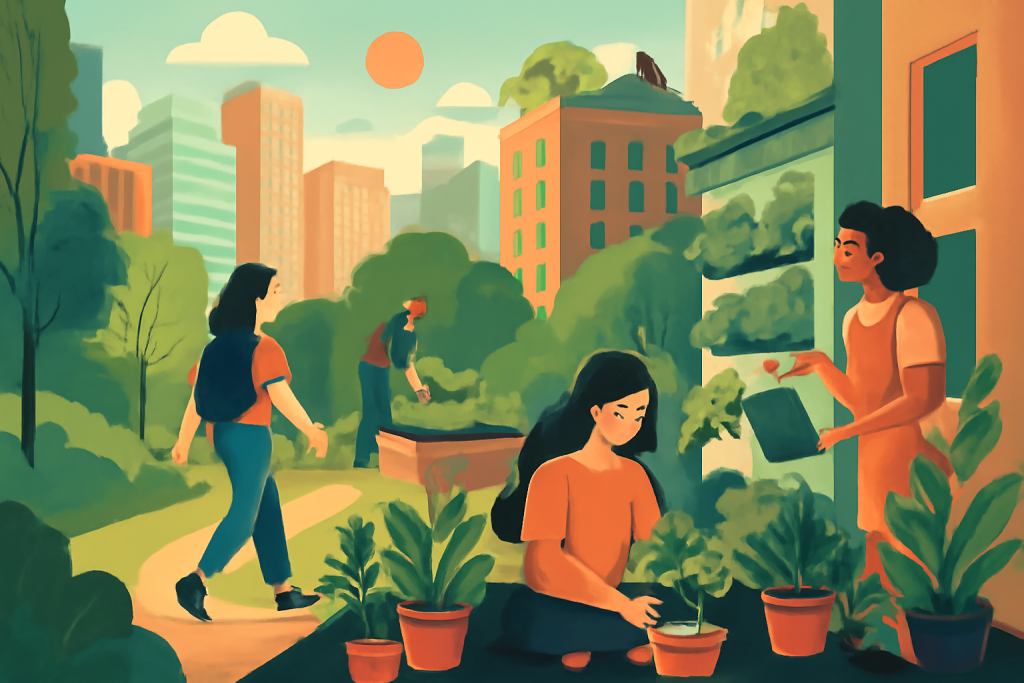Urban spaces may seem disconnected from nature, but with a little creativity, you can easily reconnect with nature in urban spaces and transform your environment into a more nature-inspired sanctuary. Here are ten practical ways to reconnect with nature while navigating city life.

1. Create a Balcony Garden
Even the smallest outdoor space can be transformed into a green retreat. Balcony gardens are an easy way to introduce nature into urban living. Incorporate small trees, flowers, and herb gardens to add color, life, and fresh air right outside your window. Many plants like succulents, ferns, and ivy thrive in limited sunlight, making them perfect for city environments.
Why it works: Growing plants helps reduce stress, boosts your mood, and purifies the air. Plus, herbs can be used in your cooking, offering both beauty and functionality.
2. Take Advantage of Green Roofs
In many cities, green roofs are gaining popularity. These rooftops are transformed into mini ecosystems, with grass, plants, and flowers. Not only do they reduce heat island effects, but they also provide an oasis for those seeking natural beauty in an urban setting.
Why it works: Green roofs are great for improving air quality and combating the urban heat island effect. Plus, they provide space for wildlife, including birds and insects, which are vital for ecosystem balance.
3. Participate in Community Gardens
Learning to reconnect with nature in urban spaces then you should know that community gardens are sprouting up in urban areas worldwide. These shared spaces allow residents to grow their own fruits, vegetables, and flowers, fostering a sense of community while reconnecting with nature.
Why it works: Community gardens not only bring nature into the city but also promote social interaction and sustainability. The act of gardening has been shown to reduce stress and improve mental health, all while helping you grow your own food.
4. Utilize Urban Parks for Outdoor Activities
Urban parks serve as the lungs of the city. They are an essential element of reconnecting with nature. Whether it’s walking, jogging, or just sitting on a bench, parks provide a space where you can immerse yourself in nature’s beauty.
Why it works: Spending time outdoors in nature is scientifically proven to reduce stress, improve concentration, and boost overall well-being. Parks also provide an opportunity for wildlife observation, making them ideal for anyone looking to connect with the natural world.
5. Install Vertical Gardens
For city dwellers with limited space, vertical gardens are an innovative solution. By utilizing vertical surfaces such as walls or fences, you can grow plants upwards rather than outwards. This technique is ideal for small apartments or homes with little outdoor space.
Why it works: Vertical gardens not only enhance the aesthetic of your space but also help to reduce air pollution by absorbing carbon dioxide and providing oxygen.
6. Start a Nature Walk Habit
Incorporating nature into your daily routine can be as simple as taking a walk through the city’s natural spaces. Look for nearby parks, riversides, or even urban greenways. Make a habit of walking regularly to connect with nature.
Why it works: Nature walks are a fantastic way to relieve stress, improve cardiovascular health, and appreciate the environment around you. They also encourage mindfulness, making it easier to disconnect from the busyness of city life.
7. Bring Nature Indoors with Houseplants
If outdoor space is scarce, houseplants can work wonders for reconnecting with nature inside your home. There are a variety of plants suited to indoor environments, from snake plants and spider plants to more exotic varieties like orchids or bonsais.
Why it works: Houseplants are not just decorative; they purify indoor air and increase humidity levels. Studies show that caring for plants can help reduce stress and enhance focus.
8. Green Your Commute
Incorporating greenery into your daily commute can also enhance your connection with nature. Consider cycling or walking through green spaces on your way to work, or opt for a bus or train ride that passes through parks or areas with trees.
Why it works: Walking or cycling through green areas allows you to get some fresh air and appreciate nature, while also boosting your physical and mental health. It’s a small change that can make your daily routine feel more natural.
9. Support Urban Wildlife
Urban environments are not only for humans. Many animals, including birds, insects, and small mammals, live in cities too. Consider setting up bird feeders, insect hotels, or even small ponds in your backyard or balcony to attract wildlife.
Why it works: Supporting urban wildlife contributes to biodiversity and ecosystem health. Birds and insects like bees play a crucial role in pollination, making them an important part of urban ecosystems.
10. Attend Nature-Based Urban Events
Cities are increasingly hosting events that help people connect with nature, from urban farms and farmers’ markets to outdoor yoga classes and nature festivals. These events offer the chance to learn about sustainable living, gardening, and other nature-related topics.
Why it works: Participating in nature-focused events helps raise awareness about environmental issues while fostering a deeper connection with the planet. It also provides opportunities to meet like-minded individuals who share your passion for nature.
Conclusion: Bringing Nature Back to Urban Living
Even in the hustle and bustle of city life, there are numerous ways to reconnect with nature. Whether it’s through gardening, walking, or supporting wildlife, taking the time to immerse yourself in natural environments can have a profound impact on your well-being. These simple steps will help transform urban spaces into greener, more sustainable environments for all.
References:
- Blair, D., & Carroll, M. (2020) ‘Urban green space and mental health: An overview of research findings’. The Journal of Environmental Psychology. 31(4), pp. 309-318. Available at: https://doi.org/10.1016/j.jenvp.2020.03.002 (Accessed: 5 May 2025).
- Lee, J., & Kuo, F. (2021) ‘The benefits of urban green spaces for mental and physical health’. Environmental Health Perspectives. 129(5), pp. 550-560. Available at: https://doi.org/10.1289/EHP5868 (Accessed: 5 May 2025).
- Hester, R. (2019) ‘The Role of Nature in Sustainable Cities’. Urban Sustainability Journal. 14(2), pp. 110-124. Available at: https://www.urban-sustainability.org (Accessed: 5 May 2025).









